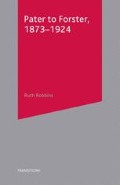Abstract
In the juxtaposition of the above quotations from H. G. Wells and Virginia Woolf there is an interesting point of comparison as well as one of contrast. George Ponderevo, speaker of the Wells passage, believes in the possibility of simple characterization in the first lines of the novel, though he goes on to except himself from the rule of pinning a person down in a phrase. His experience has been different from the common run of folk, and so his character and his points of view are more valuable, at least in his opinion. Woolf’s Mrs Dalloway who focalizes the second quotation is apparently more generous: she would not say of any one now that they could be summed up in a single phrase; she would not say it of Peter, and she would not say of it herself. Later in the novel, however, she would quite precisely sum up in simple phrases the characters she does not like — Miss Kilman (whose very name is a summing up of misanthropy and whose appearance is an indictment of her character), Sir William Bradshaw (‘Richard agreed with her … “didn’t like his taste, didn’t like his smell”’ [Woolf 1992b, 201]), and Lady Bruton (also brutally defined by a name). And even Peter Walsh is caricatured in his repeated gesture of playing with his penknife, a gesture that speaks volumes for post-Freudian readers about violence and sexuality barely repressed by a veneer of civilization.
Most people in this world seem to live ‘in character’; they have a beginning, a middle and an end, and the three are congruous with one another and true to the rules of their type. You can speak of them as being this sort of people or that. They are … no more (and no less) than ‘character actors’. They have a class, they have a place, they know what is becoming in them and what is due to them. (Wells 1978, 9, my emphasis)
She would not say of any one in the world now that they were this or that. She felt very young, at the same time unspeakably aged. She sliced like a knife through everything; at the same time was outside, looking in. She knew nothing; no language, no history. and she would not say of Peter, she would not say of herself, I am this, I am that. (Woolf 1992b, 8–9, my emphasis)
Preview
Unable to display preview. Download preview PDF.
Copyright information
© 2003 Ruth Robbins
About this chapter
Cite this chapter
Robbins, R. (2003). The Persistence of Realism. In: Pater to Forster, 1873–1924. Transitions. Palgrave, London. https://doi.org/10.1007/978-1-4039-3781-0_2
Download citation
DOI: https://doi.org/10.1007/978-1-4039-3781-0_2
Publisher Name: Palgrave, London
Print ISBN: 978-0-333-69615-6
Online ISBN: 978-1-4039-3781-0
eBook Packages: Palgrave Literature & Performing Arts CollectionLiterature, Cultural and Media Studies (R0)

